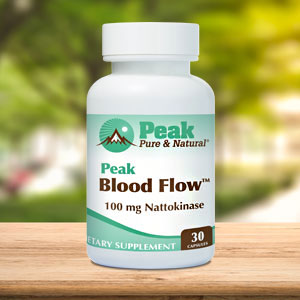Get Easy Health Digest™ in your inbox and don’t miss a thing when you subscribe today. Plus, get the free bonus report, Mother Nature’s Tips, Tricks and Remedies for Cholesterol, Blood Pressure & Blood Sugar as my way of saying welcome to the community!
COVID’s blood clot risk persists in long-COVID syndrome

If you’ve had COVID-19, you probably thought you were out of the woods once your PCR test came back negative.
But then, reality set in.
Even though the infection was gone, you were still living with a host of symptoms from shortness of breath and fatigue, to brain fog and even sexual dysfunction.
COVID just wasn’t ready to let go and you had become a long-hauler.
Sadly, Long COVID is far more common than doctors ever thought possible at the beginning of the pandemic, with some studies now showing that over a quarter of patients aren’t fully recovered at six to eight months post-infection.
It’s a phenomenon that has been tied to micro-clots and one that the medical community has been unable to offer answers for.
Now, research from RCSI University of Medicine and Health Sciences has provided greater insight into the problem of Long COVID and just how long clotting imbalance persists for those who suffer from the condition.
Clots play a role in both acute and persistent COVID-19
RCSI scientists set out to investigate the link between Long COVID and blood clotting — because as one of the lead researchers, Professor James O’Donnell puts it: “Extensive research has been carried on the dangerous clotting observed in patients with acute severe COVID-19 infection, and we now understand a lot more about how and why these deadly clots occur. In this study, we put the focus on Long COVID syndrome, as so much less is known about this persistent illness which is affecting millions of people worldwide.”
The team analyzed the blood of 50 patients with Long COVID syndrome up to 12 weeks post-infection, comparing it to the blood of healthy people without the condition.
And what they found showed that if you’ve had COVID-19, your body’s blood-clotting and immune systems can remain tipped out of balance long after the initial infection.
In fact, their results showed that the blood of patients with Long COVID syndrome had higher levels of a blood-clotting booster called von Willebrand Factor (VWF), and lower levels of a protein that normally breaks down VWF, called ADAMTS13.
In other words, their blood was primed to clot.
This could lead to a deep vein thrombosis, a pulmonary embolism — or even a stroke.
If that weren’t bad enough, their analysis also suggests that the blood vessels of patients were still being damaged long after the initial infection, and that specific cells of the immune system were at abnormal levels in patients with Long COVID.
“We saw that, in patients with Long COVID, the normally finely tuned balance of pro- and anti-clotting mechanisms were tipped in favor of blood clotting,” said Dr. Helen Fogarty, Health Research Board Irish Clinical Academic Training (ICAT) Program Fellow and lead author on the paper. “Our analysis also suggests that abnormal clotting and disturbed immunity go hand in hand in Long COVID. Together, these findings may help explain some of the symptoms of Long COVID syndrome.”
Natural circulation help
So if abnormal blood clotting is behind Long COVID, is there anything you can do to help, in order to combat your long-haul symptoms?
Firstly, of course, you should be working with your physician if there is a known clotting problem.
But in general, your lifestyle habits can make you less likely to suffer a blood clot. For example, people who are sedentary (stationary for long periods of time) are more likely to suffer a blood clot.
It’s important to keep moving. It can also help to ensure your natural blood-clotting enzyme, fibrin, isn’t overdoing its job.
Plasmin helps balance fibrin’s effects, but the body produces less and less of this blood-thinning enzyme with age.
But another enzyme that’s available through diet can help. It’s a little circulation miracle from Japan, called nattokinase or natto.
Natto has a fibrinolytic effect, breaking down the fibrin that causes clots to form and helping circulation flow freely.
It’s so powerful that it’s been the subject of several scientific studies.
And it’s easy to put natto to work for you. It can be found in supplement form as nattokinase. Or you can purchase natto to add to your meals, eating it with things like miso soup or rice and pickled veggies.
Just be sure to note that natto has a very distinct, bitter flavor and ammonia-like smell, which may turn some people off and make supplementing the best option.
Always stay on guard if you have a blood clot risk and never ignore these four symptoms.
Editor’s note: There are perfectly safe and natural ways to decrease your risk of blood clots including the 25-cent vitamin, the nutrient that acts as a natural blood thinner and the powerful herb that helps clear plaque. To discover these and other secrets of long-lived hearts, click here for Hushed Up Natural Heart Cures and Common Misconceptions of Popular Heart Treatments!
Sources:
Blood-clotting imbalance persists in Long COVID, research finds – ScienceDaily













